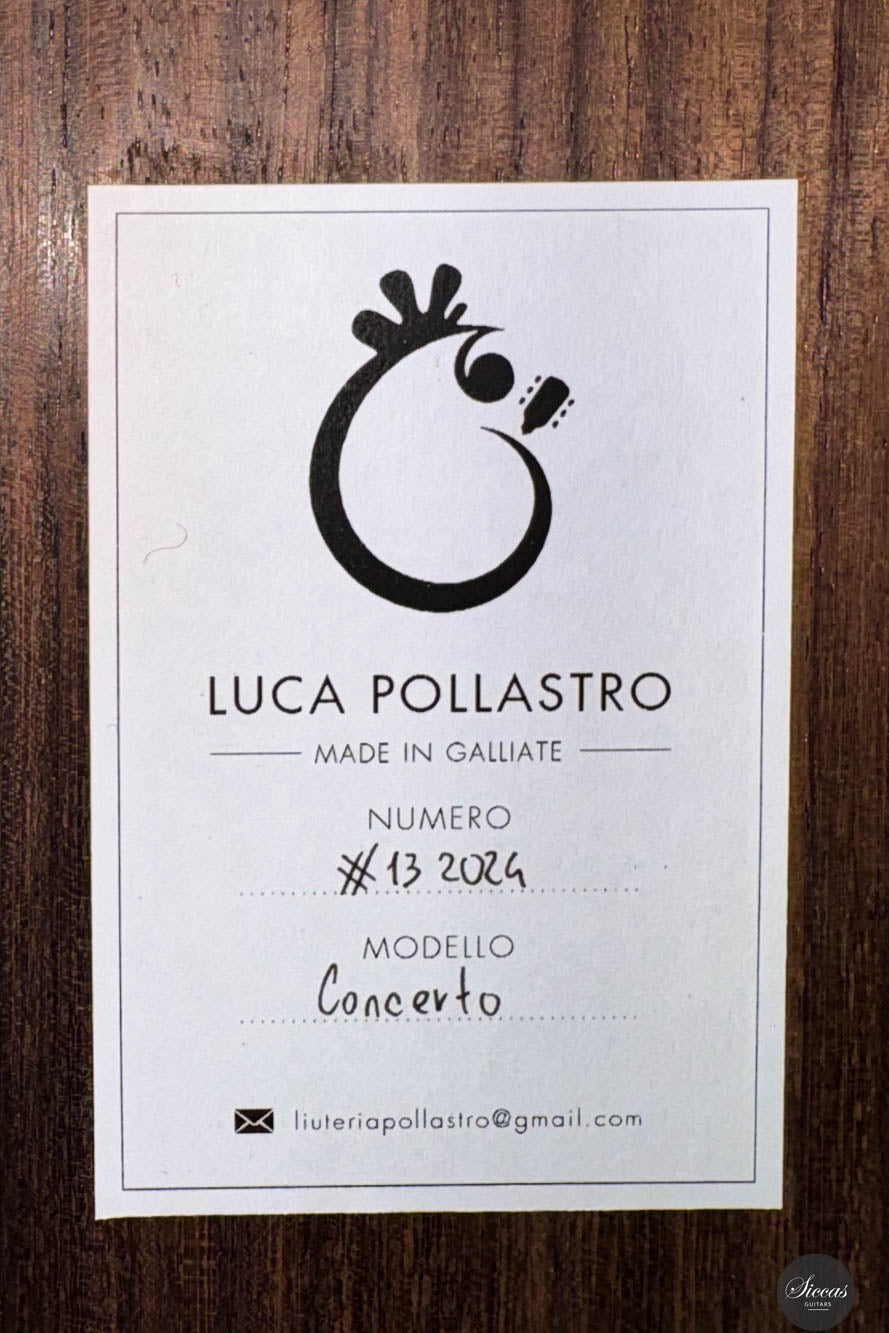Luca Pollastro - 2024 - Concerto No.13
Luca Pollastro - 2024 - Concerto No.13
Details
Details
Overview
Overview
Shipping important note
Shipping important note
Delivery times are typically reliable and most instruments arrive within the estimated timeframe.
Should any unexpected delay occur, our team will keep you informed and provide support at every step. For all shipping details and exceptions, please see our Shipping Policy.
Details about GPSR
Details about GPSR






















Video overview


More details about the guitar
About the luthier
Born in Galliate in 1994, Luca Pollastro discovered his passion for woodworking and music at a young age. During his final years of high school, he began building musical instruments as a self-taught craftsman. In 2015, he enrolled at the Civica Scuola di Liuteria in Milan, specializing in plucked instruments, and graduated as a Master Luthier under the guidance of Lorenzo Lippi and Fabio Bonardi. After completing his studies in 2019, Luca refined his expertise in classical and acoustic guitars through an apprenticeship with Aldo Illotta. In 2020, he established his own workshop in Galliate, focusing on crafting classical guitars and repairing plucked instruments. By 2024, he debuted as an exhibitor at the prestigious Roma Expo Guitars. Guided by a philosophy rooted in tradition, Luca draws inspiration from the great masters of the past while addressing the needs of modern guitarists. His meticulous selection of woods, attention to detail, and commitment to sound structure and playability make his instruments distinctive and highly sought after.About the guitar
The concert guitar numbered 13, built using traditional animal glue and a personal seven-fan bracing system with transverse reinforcements, produces a voice that balances traditional warmth with the demands of contemporary guitarists. Its dynamic range, clarity, balance, and rich timbre are complemented by exceptional comfort and playability. The woods are carefully chosen for their aesthetic and mechanical properties: the back and sides feature quarter-sawn Indian rosewood with over 20 years of seasoning, and the soundboard is made from fine Val di Fiemme spruce. Decorative elements highlight Luca’s craftsmanship, with custom-made bindings of maple, ebony, and solid snakewood, accentuating the tonal and visual harmony of the selected woods. The rosette features a striking pyramid motif framed by these bindings, further enhancing the guitar’s refined aesthetic. A quarter-sawn cedrella neck and African ebony fingerboard complete the design, with the entire instrument polished to perfection using hand-applied French polish.Regular care extends the life of the instrument
Even with careful use, a classical guitar may gradually change in appearance or respond to unstable storage conditions. Have a close look at your guitar regularly and be attentif to changes. If your instrument is suffering from its environement, it will let you know.
Protect Your Guitar: Handle with Care
Be mindful when touching your instrument with greasy or unwashed hands: any skin contact is a small attack on the varnish. Of course, a guitar is made to be played, but taking a few precautions helps preserve its beauty: wash your hands before playing, wear long sleeves, and avoid unnecessary direct skin contact with the body of the instrument.
Pro tip: Avoid playing with a button-up shirt, heavy jewelry, or a belt, as these can scratch the guitar. Also, make sure your guitar case is free of any objects that could damage the instrument during storage.
String care
A good habit to adopt is wiping down your strings briefly after each playing session. This small action significantly extends their lifespan and helps maintain a consistent, comfortable feel under your fingers.
Most importantly, clean strings are essential for keeping your instrument in tune. Corrosion, sweat, and dust can affect the uniformity of the strings and interfere with accurate tuning across the entire fingerboard.
Pro tip: If you're having trouble getting your guitar in tune, it might be time to change the strings. A useful test is to compare the pitch of the 12th fret harmonic with the fretted note at the 12th fret; if there's an unusually large gap between them, your strings may have lost their integrity and should be replaced.
Keep Your Shellac Finish Shining!
Got a guitar with a shellac (French polish) finish? Here's a simple trick: Take a clean microfiber cloth and gently breathe on the surface to create a light mist. Then, softly rub to remove fingerprints, sweat, and grease. That’s usually all it takes to keep it looking great, no products needed!
Pro tip: Every few years, treat your guitar to a check-up with a luthier to keep it in top shape.
Storing Your Guitar: Climate Matters
Your guitar can safely stay outside its case, as long as the surrounding environment maintains 42–55% humidity and a temperature between 18–25°C.
Keep in mind that humidity levels can still fluctuate inside the case, especially during seasonal changes.
- Too much humidity may cause overtightened strings and a dull tone.
- Too little humidity can lead to a bulging top, string buzz, or even cracks.
Avoid placing your guitar near radiators, air conditioners, or windows with direct sunlight.
Pro tip: Always close your guitar case while playing. This helps preserve a stable microclimate inside the case, so your instrument is protected the moment you put it back in.















































